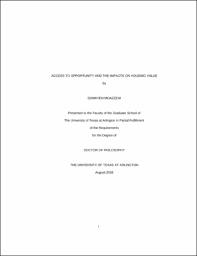
ATTENTION: The works hosted here are being migrated to a new repository that will consolidate resources, improve discoverability, and better show UTA's research impact on the global community. We will update authors as the migration progresses. Please see MavMatrix for more information.
Show simple item record
| dc.contributor.advisor | Hamidi, Shima | |
| dc.creator | Moazzeni, Somayeh | |
| dc.date.accessioned | 2019-02-07T17:56:33Z | |
| dc.date.available | 2019-02-07T17:56:33Z | |
| dc.date.created | 2018-08 | |
| dc.date.issued | 2018-08-13 | |
| dc.date.submitted | August 2018 | |
| dc.identifier.uri | http://hdl.handle.net/10106/27671 | |
| dc.description.abstract | Accessibility is the well stablished concept in theories of urban planning and spatial structure. This dissertation measured access to opportunities that incorporate major destinations as well as all jobs for three modes. The study used the most updated transportation network to measure access to opportunities by gravity equation that account for distance and mode. It also used Principal Component Analysis to make the opportunity scores out of several related destinations and to make overall score by incorporating all the opportunities.
The developed access to opportunity scores were applied to evaluate the location efficiencies of major affordable housing units in DFW. I found that most of affordable housing units are located in least location efficient places by walking and transit. However, among them, HCV and LIHTC affordable programs presented a better performance than other ones.
The new score was used to determined areas with the high and low access chances for DFW. Based on the analysis for this research, the residents had poor access to opportunities by walking and transit and good access to opportunities by driving. I also used the developed scores to examine the spatial distribution of new development projects in areas of opportunities. I found that most of the projects are happening in areas that have low access to opportunities by walking and transit, but they have good access by car.
Moreover, the relation to housing value is the topic of large volume of the studies. However, currently, there have been some changes in household travel behavior. Households are reported to commute less to access jobs due to the advances in communication and information technologies. In addition, they travel more to access the destinations other than jobs. Moreover, US families showed the demand to use more active mode of transportation such as biking and walking for commuting to work. These new trends might have the reflection on housing value. This study attempted to examine the topic by developing two models to compare the impact of access to job with the impact of access to the destinations other than job. The result of this study showed that housing market is still influenced by job accessibility. | |
| dc.format.mimetype | application/pdf | |
| dc.language.iso | en_US | |
| dc.subject | Access to opportunities | |
| dc.subject | Housing value | |
| dc.title | ACCESS TO OPPORTUNITY AND THE IMPACTS ON HOUSING VALUE | |
| dc.type | Thesis | |
| dc.degree.department | Urban and Public Affairs | |
| dc.degree.name | Doctor of Philosophy in Urban Planning and Public Policy | |
| dc.date.updated | 2019-02-07T17:56:33Z | |
| thesis.degree.department | Urban and Public Affairs | |
| thesis.degree.grantor | The University of Texas at Arlington | |
| thesis.degree.level | Doctoral | |
| thesis.degree.name | Doctor of Philosophy in Urban Planning and Public Policy | |
| dc.type.material | text | |
Files in this item
- Name:
- MOAZZENI-DISSERTATION-2018.pdf
- Size:
- 4.877Mb
- Format:
- PDF
This item appears in the following Collection(s)
Show simple item record


